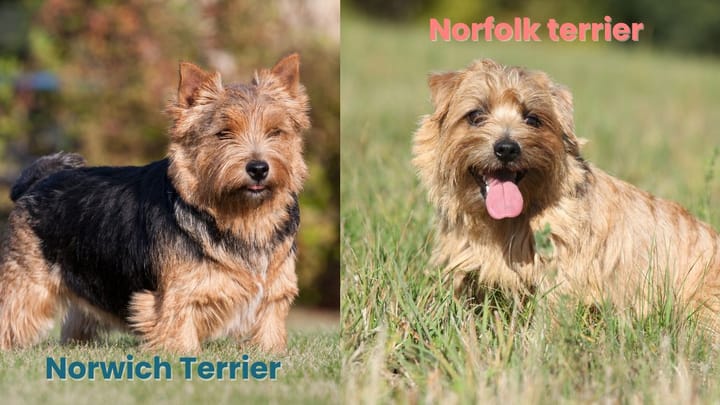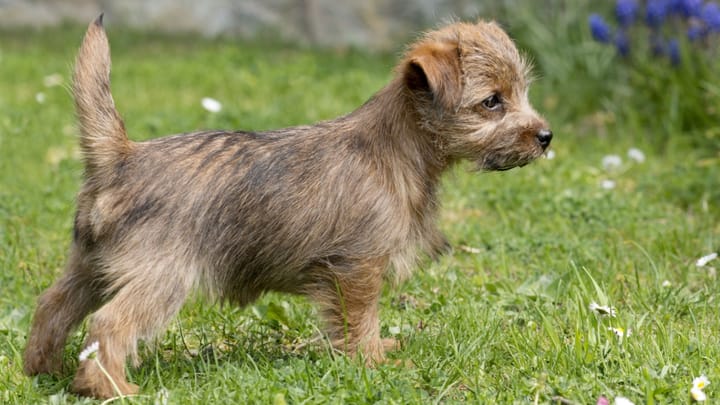Norfolk Terrier and Norwich Terrier
Other name: Norfolk


The Norfolk Terrier : a jolly little dog, easy-going in company but fearless in the field, she loves humans and detests rodents. While the Norfie will make an excellent addition to a variety of homes, it is important to note that she is not quite the teddy-bear that she appears. From the mouse to the fox, there is no size of foe, below human knee-height, that will intimidate the mighty Norf; but she does not fight for fighting’s sake, and will not start trouble unless she senses unwelcome company. She has an independent streak, and can be fiercely protective of her people. She needs a lot of exercise and may be better suited to country life than the big city. But she is a lot of fun, incredibly cute, and great company.
|
Life expectancy |
The Norfolk Terrier and Norwich Terrier has a life expectancy of between 12 and 14 years |
|
Temperament |
|
|
Size |
Small
|
|
Adult size |
Female
Between 9 and 10 in
Male
Between 9 and 10 in
|
|
Adult weight |
Female
Between 9 and 13 lb
Male
Between 9 and 13 lb
|
|
Coat colour
Red, wheaten, black and tan, or grizzle (blend of all the above). Possible white patches. |
Black Red Sand |
|
Type of coat
Mid-length; longer around neck and shoulders. The type of the coat is hard, wiry, flat to the body. |
Long Hard |
|
Eye colour
Dark brown or black. |
Brown
|
|
Purchase price |
The Norfolk Terrier and Norwich Terrier costs between £645 and £1100 |
Although not as rare as her cousin the Norwich Terrier, the Norfolk can be hard to come by and there may be a waiting list to join.
More details about the Norfolk Terrier and Norwich Terrier
Norfolk Terrier and Norwich Terrier: Origins and history
The Norfie can count among her ancestors such distinguished terriers as the Glen
of Imaals, red Cairn Terriers and Dandie Dinmonts. At some point in the 19th century, a distinctive reddish off-shoot appeared among the unpretentious and little-distinguished farm dogs of Norfolk county, who worked daily to keep local vermin in order alongside other duties as required.
This off-shoot eventually became known as the Norwich Terrier, and was accepted onto the books of the Kennel Club in 1932. Along the way, she picked up such names as the Cantab or Trumpington Terrier, as she had been adopted first into Cambridge University life (where her ratting skills were first rate) and later to stables on nearby Trumpington Street, where Jodrell Hopkins made a business of breeding the creatures for his fellow students.
One such Trumper, Rags, ended up in the employ of Frank “Roughrider” Jones, who bred him with a hunt terrier/Dandie Dinmont cross named Ninety, their red-haired children becoming an important terrier family. In fact, the dog is known as a Jones Terrier in the States.
But varieties with both upward- and downward-pointing ears continued to be recognised as the same breed until 1964, when a campaign to acknowledge that somewhere along the line one strain of Norwich Terriers had become quite a different dog was finally ceded by the UK Kennel Club. The down-eared dog was christened the Norfolk, and eventually became the more popular of the closely-related breeds.
Physical characteristics of the Norfolk Terrier and Norwich Terrier
Not to be mistaken, for fear of causing offence, with the Norwich Terrier, the Norfolk is a tiny bit longer than the Norwich, and her ears flap down rather than pointing up. However, the two breeds are together described as the smallest of the working terriers. The key word here is ‘working,’ since the Norfie should not be mistaken for a toy. She is strong and agile. Her dark little eyes peep urgently through her fringes in search of love or vermin. A perfect button nose crowns her strong, door-stop-shaped beak. Her tail stands tall like an antenna, and her coat is wiry and fringed at the extremities. In some ways, she resembles a little quadruped Wookie; a mistaken identity that she encourages when she opens her mouth to alert you to unexpected company.
FCI classification of the Norfolk Terrier and Norwich Terrier
-
Group 3 - Terriers
-
Section 2 : Small sized Terriers
Norfolk Terrier and Norwich Terrier: Varieties
- Norwich Terrier
Norfolk Terrier and Norwich Terrier: Characteristics
Norfolk Terrier and Norwich Terrier: Behaviour
Training a Norfolk Terrier and Norwich Terrier
She is quite straightforward to train, and it is essential that owners do so since she can be quite a free spirit without the education required for participation in conventional society.
Norfolk Terrier and Norwich Terrier: Lifestyle
Breed compatibility Norfolk Terrier and Norwich Terrier
Norfolk Terrier and Norwich Terrier: Purchase price
The average price for a Norfolk Terrier dog is between £645 - £1100.
The Norfolk Terrier can cost around £40 per month to feed and maintain.
Norfolk Terrier and Norwich Terrier: Shedding
Average
Shedding is moderat, but this breed is considered to be hypoallergenic.
Norfolk Terrier and Norwich Terrier: Grooming
The Norf requires her outer hair to be hand-stripped twice a year to make way for new growth. This skill can easily be learned by her human housemates, or outsourced to a reputable local dog salon.
Norfolk Terrier and Norwich Terrier: Health
12-14 years.
She’s a strong dog, bred for serious outside work and skirmishes with rodents and other verminous critters who may more than make her match in size.
Her coat is well designed, like a Thermos flask, to keep her cool in hot weather and warm in cold weather. However, like any dog, over-heating is a serious issue if it occurs, so caution should be taken not to over-work her on sunny days, and to ensure she has constant access to shade and drinking water.
Her coat is well-suited to insulating her from the trials of a long winter walk, but don’t push your luck.
She does have a tendency to weight-gain, particularly if she is over-fed and/or under-exercised.
- Mitral valve disease (MVD)
- Patellar luxation
- Cataracts
- Lens luxation
- Glaucoma
- Coloboma
Do you want a Norfolk Terrier and Norwich Terrier dog ?
Oh no...
There are no Norfolk Terrier and Norwich Terrier adoption profiles at the moment...




